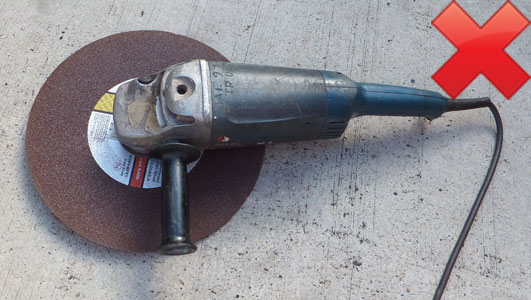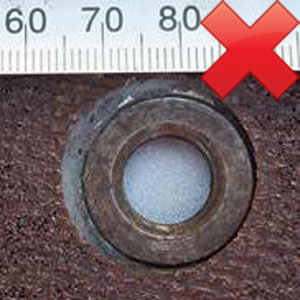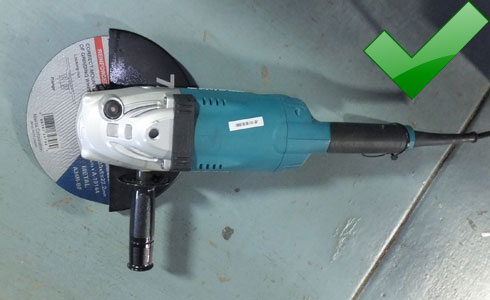Guards and discs on angle grinders
Issued: 4 March 2016
Last Updated: 20 November 2017
Purpose
The purpose of this safety alert is to highlight the risks associated with removing guards and using incorrect discs on angle grinders.
Background
In February 2016, a worker was killed while operating a 9 inch (230 mm) angle grinder when part of a broken disc struck his chest. It appears that the high impact of the projectile caused fatal internal injuries.
Many other workers have been seriously injured when angle grinders have kicked back, causing cuts and lacerations.
Contributing factors
One major contributing factor is the use of cutting discs that are too large for the angle grinder. In some cases the guards have been removed and the grinder fitted with a 14 inch (356 mm) cut-off disc.
Cutting discs are usually designed for a maximum outside edge speed (i.e. peripheral speed) of approximately 70 metres/second (m/s) (250 kilometres per hour (kmph)). Larger angle grinders are manufactured with lower revolutions per minute (RPM) than smaller angle grinders, so that the edge speed of the disc always remains around 70 m/s.
Fitting a 14 inch (356 mm) cut-off disc to a 9 inch (230 mm) angle grinder will increase the edge speed excessively to at least 120 m/s (430 kmph). Photograph 1 shows an angle grinder with the wrong size cutting disc fitted and the guard removed. Larger discs are not designed for the higher speed of smaller grinders and if used, risk the disc shattering and striking the user and others.
Guards should be provided and used on all power tools where there is a risk of the disc ejecting, disintegrating or cutting the worker. If the guard has been removed:
- there is nothing to stop the broken pieces hitting the worker
- the worker's hand will be closer to the unguarded moving blade
- there is also a greater risk of the blade being damaged when the angle grinder is put down and the weight of the grinder is resting directly on the disc.
Another factor that increases the risk of disc failure is when the central disc hole size is too large for the spindle flange on the angle grinder. As the disc diameter increases so will the hole size. For example, the hole size of a 14 inch (356 mm) cut-off wheel is typically 25.4 mm compared to 22.3 mm on a 9 inch (230 mm) cutting disc (see Photograph 2). If the disc hole is too big for the spindle flange, the disc may be off centre, become unbalanced, vibrate excessively and rapidly lead to it shattering. Photograph 3 shows a 9 inch (230 mm) angle grinder correctly fitted with guard and the right sized disc.

Photograph 1: Unsafe 9 inch (230 mm) angle grinder with 14 inch (356 mm) disc fitted and guard removed.

Photograph 2: Unsafe excessive clearance for the central hole on 14 inch (356 mm) disc on 9 inch (230 mm) spindle flange.

Photograph 3: 9 inch (230 mm) angle grinder with guard and right sized disc fitted.
Action required
Always:
- Use an angle grinder with the correct guard supplied by the manufacturer.
- Fit the right sized disc that has a hole matching the spindle flange.
- Ensure discs are marked with the maximum permissible operating speed (rated speed) in RPM.
- Ensure the angle grinder is marked with its maximum operating speed (rated speed) in RPM.
- Ensure the rated speed marked on the disc is not less than the rated speed marked on the angle grinder.
- Use the tightening tool supplied by the grinder manufacturer to tighten the disc. Using another device (i.e. punch and hammer) can damage the disc and grinder.
- Hold the angle grinder with both hands ensuring the side handle is inserted on the side of the unit that gives the best grip for the work activity.
- Use a grinding disc for grinding. Grinding with a cutting disc damages the disc and increases the likelihood of the disc breaking.
- Ensure damaged discs are thrown out and not re-used.
- Allow the grinder to run to speed before cutting or grinding.
- Use the correct spindle flange and lock nut for the disc and make sure these are fitted the way the angle grinder manufacturer shows in the instruction manual. The type of flange or fitting method may vary for cutting and grinding discs. If the incorrect flange and lock nut combination are used, the disc can be damaged and lead to premature failure.
Further information
Further information can be obtained from the following: